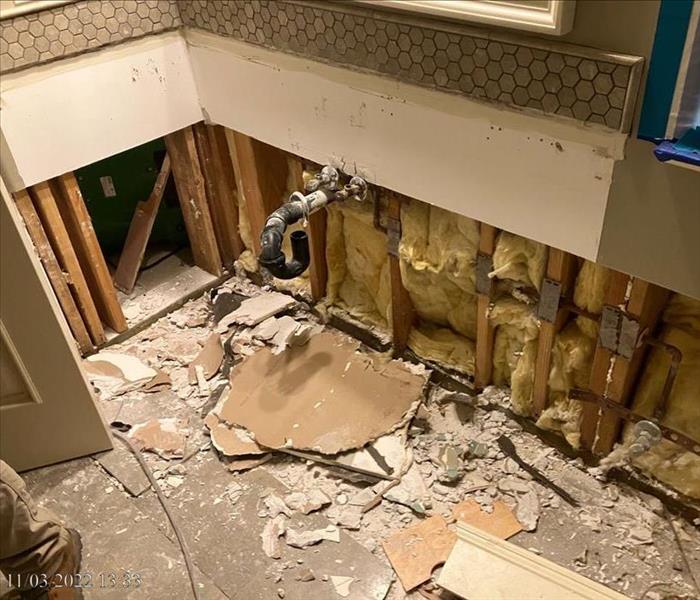Mold in Crawl Spaces: Prevention and Remediation
3/13/2024 (Permalink)
 We will explore the reasons behind mold in crawl spaces and provide tips on how to remediate and prevent mold effectively.
We will explore the reasons behind mold in crawl spaces and provide tips on how to remediate and prevent mold effectively.
Having mold in your crawl space can be a common and concerning issue for homeowners. While mold growth poses potential risks to your property, it is important to understand the causes and effective prevention and remediation strategies for tackling mold in crawl spaces. In this blog, we will explore the reasons behind mold in crawl spaces and provide tips on how to remediate and prevent mold effectively.
Causes of Mold in Crawl Spaces
Crawl spaces offer a perfect environment for mold growth due to various contributing factors. Understanding these causes will help you prevent mold in your crawl space. Here are some common causes:
- Moisture: Excess moisture is the primary culprit behind mold growth in crawl spaces. Moisture can enter crawl spaces through the ground, foundation cracks or leaks, plumbing issues, or inadequate drainage. Once moisture accumulates in the space, it promotes the growth of mold.
- Poor Ventilation: Inadequate ventilation in crawl spaces hampers airflow, allowing moisture and humidity to build up. The lack of proper airflow creates a damp environment that is conducive to mold growth.
- Insufficient Insulation: Improper or insufficient insulation can lead to condensation in crawl spaces. If warm, humid air comes into contact with cooler crawl space surfaces, condensation occurs, providing the ideal conditions for mold growth.
Remediation of Mold in Crawl Spaces
If you discover mold in your crawl space, taking immediate remediation measures is essential to prevent further damage. Follow these effective strategies:
- Identify and Fix the Source of Moisture: Start by identifying and resolving the source of moisture in your crawl space. Look for plumbing leaks, foundation cracks, or other areas where water may be entering. Fixing these issues is crucial to prevent recurring mold growth.
- Improve Ventilation: Enhancing ventilation is vital in reducing moisture levels. Consider installing vents or fans to promote air circulation in your crawl space. Ventilation can help remove excess moisture and prevent mold growth.
- Remove Mold-Infested Materials: If there are porous materials in your crawl space that have been extensively affected by mold, such as insulation or wooden beams, it may be necessary to remove and replace them to eliminate the mold thoroughly.
- Clean and Disinfect: Using a mold cleaner recommended for use in crawl spaces, scrub the affected areas thoroughly to remove visible mold growth. Ensure that you clean both the surfaces and the surrounding area to prevent further contamination.
- Encapsulate the Crawl Space: Encapsulation involves sealing the crawl space with a moisture-resistant barrier to prevent moisture intrusion. This method can help control humidity levels and prevent future mold growth.
Prevention of Mold in Crawl Spaces
Prevention is key to avoiding mold in your crawl space. Here are some preventive measures:
- Install Vapor Barriers: Lay down vapor barriers on the ground to prevent moisture from seeping into your crawl space. These barriers act as a protective layer between the ground and your crawl space, reducing the potential for mold growth.
- Maintain Proper Drainage: Ensure that your gutters are directing water away from your foundation. Regularly check and clean your drains to prevent any blockages that may cause water to pool around your crawl space.
- Monitor Humidity Levels: Consider installing a dehumidifier in your crawl space to maintain humidity levels below 50 percent. Monitoring and controlling humidity significantly reduce the chances of mold growth.
- Regular Inspections: Schedule regular inspections of your crawl space to catch any potential issues such as leaks or condensation before they escalate. Promptly addressing these issues can prevent mold growth.
Understanding the causes, remediation, and prevention strategies is crucial when dealing with mold in crawl spaces. By addressing moisture sources, improving ventilation, and implementing preventive measures, you can effectively remediate existing mold and prevent its recurrence. Regular maintenance, inspections, and vigilance will help ensure a clean and mold-free environment in your crawl space.

 24/7 Emergency Service
24/7 Emergency Service